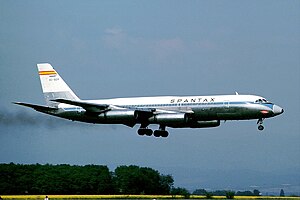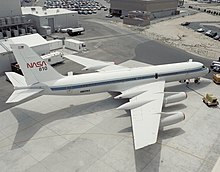Convair 990 Coronado
This article needs additional citations for verification. (August 2009) |
| Convair 990 Coronado | |
|---|---|

| |
| Convair CV-990A of Spantax at Basel Airport. Even at landing power the smoky engines are evident. | |
| Role | Narrow-body jet airliner |
| Manufacturer | Convair |
| First flight | January 24, 1961 |
| Retired | mid-1980s |
| Primary user | American Airlines |
| Produced | 1961-1963 |
| Number built | 37 |
| Developed from | Convair 880 |
The Convair 990 Coronado was a narrow-body jet airliner produced by the Convair division of General Dynamics, a "stretched" version of their earlier Convair 880 produced in response to a request from American Airlines. The 990 was lengthened by 10 feet, which increased the number of passengers from between 88 and 110 in the 880, to between 96 and 121 (depending on the interior). This was still considerably fewer than the contemporary Boeing 707 (110 to 189) or Douglas DC-8 (105 to 173), although the 990 remained some 25 to 35 mph faster than either in cruise.
Design and development
American Airlines requested that Convair design an aircraft for coast-to-coast flights, able to fly nonstop New York to Los Angeles against westerly winds. They wanted somewhat larger passenger capacity than the 880, which was the smallest of the first-generation U.S. jet airliners. The 990 entered production in 1961.
One change from 880 was the addition of large anti-shock bodies on the upper wings to increase their critical Mach and reduce transonic drag. This allowed the heavier 990 to go slightly faster than the 880, cruising at about Mach 0.91, making it the fastest subsonic passenger jet ever built. Only the supersonic Concorde and Tu-144 have ever carried commercial passengers at a faster speed. Originally, there were plans to use the bulges as fuel tanks, but during test flights the extra weight caused the tanks to vibrate excessively. Instead, the inner set of bumps also served a secondary role as fuel dump for the fuel tanks in the fuselage.
The engines were also changed to the uprated General Electric CJ-805-23s, which were unique in that they used a fan stage at the rear of the engines, compared to the fan stage at the front of the engine as found in the Pratt & Whitney JT3D that powered the 990's competitors. The engine was a simplified, non afterburning civilian version of the J79, used in military fighters. Like the J79, the CJ805 was very smoky.
Like the 880, 990s were later modified with a dorsal "raceway" added to the top of fuselage to hold the wiring for additional instrumentation.
Operational history
Early versions of the 990 did not meet the specifications promised to American Airlines, which reduced its order as a result. As a result, the 990A was developed by adding fairings to the engine nacelles, pylons and the lower surface of the wing. Convair and GE aerodynamicists designed these modifications using a local area rule. The resulting modifications significantly delayed the high-speed drag rise of the aircraft.[1] Despite these modifications, the aircraft never did live up to its promise of coast to coast non stop capability westbound from JFK to LAX. American Airlines timetables show little or no difference in scheduled time between 707 and 990A flights; AA began to dispose of its 990As in 1967, having found the 707 and 720 more suited to its routes in spite of their larger capacity.

Swissair bought eight 990As from 1962 onwards, operating them on long distance routes to South America, West Africa, the Middle and Far East, as well as on European routes with heavy traffic. Their fleet was withdrawn from service in 1975. Scandinavian Airlines also operated Coronados on their long haul schedules to Tokyo and other points in the Far East.
The 990's market niche was soon to be captured entirely by the Boeing 727 and the Boeing 720 (a derivative of the 707), and by the time the line was shut down in 1963, only 37 990s had been produced, bringing General Dynamics' entire production of commercial jet airliners to 102 airframes. The failure of the Convair 880 and 990 to be accepted by the airlines led Convair to suffer what at the time were the largest corporate losses in history.
When the major airlines retired their Convair 990s, they found a second life operating for charter airlines. Spantax of Spain had a large fleet until they were gradually retired in the mid 1980s.
Variants
- 990 : Initial production version.
- 990A : Faster cruising speed and longer range.[2]
Operators


- Aerolíneas Argentinas
- Aerolíneas Peruanas S.A. Aerolineas Peruanas operated two Convair 990As from Callao International Airport, Lima.[3]
- Air France
- Alaska Airlines
- American Airlines
- AREA Ecuador
- Cathay Pacific
- Ciskei International Airways
- Denver Ports of Call
- Garuda Indonesian Airways
- Internord
- Lebanese International Airways
- Middle East Airlines
- Modern Air Transport
- NASA
- Nomads Travel Club
- Nordair
- Northeast
- SAS
- Spantax
- Swissair
- Thai Airways International
- Varig / Real-Aerovias
Accidents and incidents
- May 30, 1963 — An American Airlines Convair 990 was destroyed by fire at Newark International Airport, New Jersey, USA.
- May 28, 1968 — A Garuda Indonesia Airways Convair 990 crashed in a nearly vertical attitude, some 4–5 minutes after takeoff from Bombay-Santacruz Airport outside Mumbai, India, killing all 14 crew and 15 passengers.
- January 5, 1970 — A Spantax Convair 990 crashed near Stockholm-Arlanda Airport outside Stockholm, Sweden while taking off on a three-engine ferry flight to Zürich, Switzerland, killing five crew.
- February 21, 1970 — A Swissair Convair 990 crashed near Würelingen, Switzerland while trying to return to the airport after an explosion in the aft of the aircraft, killing all nine crew and 38 passengers.
- August 8, 1970 — A Modern Air Transport Convair 990 crashed on approach to Acapulco-Alvarez International Airport, Mexico, Killing one crew.
- December 3, 1972 — A Spantax Convair 990 crashed at Los Rodeos Airport on the island of Tenerife while taking off in almost zero visibility, killing all seven crew and 148 passengers.[4]
- March 5, 1973 — A Spantax Convair 990 on a flight from Madrid to London was involved in a mid-air collision with an Iberia McDonnell Douglas DC-9 over Nantes. The Spantax aircraft lost part of its left wing, but its pilots managed to land safely at Nantes Airport. The Iberia DC-9 crashed killing all 68 passengers and crew on board.
- April 12, 1973 — A U.S. Navy Lockheed P-3C (157332) operating from NAS Moffett Field in Sunnyvale, California collided with a Convair CV-990 (N711NA) operated by NASA during approach to runway 32R. The aircraft crashed on the Sunnyvale Municipal Golf Course, half a mile short of the runway, resulting in the destruction of both aircraft and the deaths of all aboard except for one Navy crewman.[5][N 1]
- September 10, 1973 — A California Airmotive Corp. Convair 990 veered to the left and collided with a GCA unit after landing in heavy rain on Guam-Agana airport, Guam.
- July 17, 1985 — A NASA Convair 990 suffered a blown tire during take-off and caught fire at Riverside-March AFB, California, USA
Aircraft on display
Several 990s have survived. A former Swissair Convair 990 is on display in the Swiss transportation museum, the Verkehrshaus in Luzern, while two are owned by the Mojave Spaceport. Of these, one is on display at the airport's entrance, and the other is used for movie and television filming projects.
Specifications (Convair 990A)
Data from Macdonald Aircraft Handbook[6]
General characteristics
- Crew: Four
- Capacity: 131 passengers
Performance
See also
Related development
Aircraft of comparable role, configuration, and era
Related lists
References
- Notes
- ^ One Navy crewman in the P-3 did survive the crash. He was in the P-3's tail section, which broke off the aircraft as the 990 collided from above. He fell out of the broken tail section and survived with massive injuries. People at the golf course who witnessed the crash, tried to break open windows on the wreckage with golf clubs in a futile attempt to pull the injured out before fire consumed the crews.
- Citations
- ^ Kutney, John T. and Stanley P. Piszkin. "Reduction of Drag Rise on the Convair 990 Airplane". AIAA Journal of Aircraft, Vol. 1 No. 1, January-February 1964, pp. 8–12.
- ^ "The Might-Have-Beens: Convair 880 and 990." Airliners.net. Retrieved: August 20, 2011.
- ^ "World Airline Survey Flight International]], April 14, 1966, p. 595. Retrieved: December 23, 2011.
- ^ Gero 1997, p. 111.
- ^ "Accident description: 12 APR 1973." Aviation Safety Network. Retrieved: August 20, 2011.
- ^ Green 1964, p. 225.
- Bibliography
- Gero, David. Aviation Disasters. Yeovil, Somerset, UK: Patrick Stephens Ltd (Haynes Publishing), 1997. ISBN 1-85260-526-X.
- Green, William. Macdonald Aircraft Handbook. London. Macdonald & Co. (Publishers) Ltd., 1964.
- Proctor, Jon. Convair 880 & 990. Miami, Florida: World Transport Press, 1996. ISBN 0-9626730-4-8.
- Taylor, John W. R. Jane's All The World's Aircraft 1965-66. London: Samson Low, Marston, 1965.
- Wegg, John. General Dynamic Aircraft and their Predecessors. London: Putnam, 1990. ISBN 0-85177-833-X.
